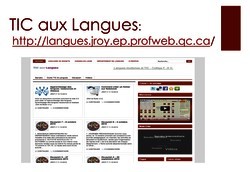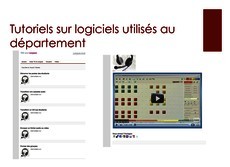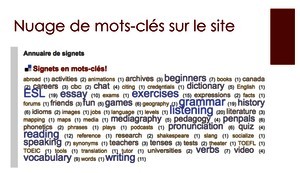The Modern Languages Departmental Blog
Jean-Francois Roy, professor of ESL and now Coordinator of the Modern Languages Department, described
Jeff’s Economics Cafe in his Fall 2009 story. There we learned about the impact of Joomla on students through social networking.
A new meeting space for the department, a blog called TIC aux langues was created with WordPress and has become a site of animated academic exchanges among department members. A short tour of its Web 2.0 features in text and video interview follows.

“Le Tic aux Langues” homepage is hosted on the Profweb Personal Space.
A- Beginner, Intermediate or Advanced?
The most popular section of the blog has so far been the online tutorials. They began with a few short podcasts to help teachers understand how to use software associated with the language lab. These short videos became all the more useful with the acquisition of our second multimedia laboratory last year. Thanks to this change, the number of teachers who use the new technology has doubled, and this kind of online support has really helped teachers rise to the challenge.
Profweb Interview with ‘Jeff’ Roy
Interview with Jeff Roy.
Sanako Software
Sanako software, well known to language teachers, is a very powerful tool, offering many options. Just in the Quebec City area, there are five colleges using it. Our school adopted it in 2005. I created video capsules explaining how to use Sanako software for three user skill levels: beginner, intermediate and advanced.
The software can handle certain class management activities like monitoring applications in use, tracking the classroom’s computers, transferring files and especially initiating projects. It can even conduct evaluations. It basically gives the teacher tools to interact with students and establishes connections between the students themselves. Students can be asked to perform various tasks such as producing a personal recording or listening to an audio or video capsule.

The Tutorials Page.
Synchroneyes Software
I also produced podcasts about this related software. If certain features of classroom management in Sanako and SynchronEyes overlap, SynchronEyes has the advantage of being easier to use and allows you to block access to the Internet.
B – A Departmental Community of Users
Delicious – A Remarkable Tool for Collaboration
In my opinion, one of the best Web 2.0 tools is the bookmark creator – Delicious. We recently integrated Delicious into our department’s teacher user profile so that it works even in the browser Internet Explorer. When one of my colleagues finds a resource or an interesting article, he clicks on Delicious, and marks the site indicating relevant keywords. That link becomes part of our collection of web bookmarks. Suggestions will be reviewed by a departemental committee. I have also recorded a demonstration on how to import bookmarks with Delicious in Le TIC aux langues.
We of course already have a list of sites suggested by the Department of Modern Languages. We also use many from the CCDMD catalog Internet Directory for English language improvement. Our bookmark album contains the collection of proposed sites in the form of a word cloud. It is easy to link to the online resource from the Delicious album and certainly faster than the paper catalog.
The Delicious topics of our users suggest how we classify sites. There are no fixed categories. We are looking forward to the gradual incorporation of this information into our teaching.
Currently, there are some small synchronization issues between WordPress and Delicious. Sometimes, some descriptions of resources do not appear. It is an irritant that Khalid Gueddari (our former extraordinary IT Rep) and I have been working on.

The Delicious Word Cloud.
The Deuspich Section
The term “Deuspich” represents the brotherhood of the department, with its three main languages: German, Spanish and English. In the blog, this section targets our language monitors. Access is currently private, and I also file departmental or college documents, our weekly newsletters and other memorabilia.
This section is our social web that allows us to avoid having too many meetings and keeps up contact with professors on leave. An RSS feed will be activated soon eliminating the current need to use e-mail to indicate the arrival of news.
C- Departmental Affairs Management
The blog led to the idea of an online calendar. Managing the common agenda, which among other things charts lab reservations, is a reality that we have faced every day for some time within the department. We have managed our laboratory schedule on an informal friendly basis, but the way we operate requires constant internal supervision. Up until now, a paper copy of the master schedule has been posted in our offices. We will soon learn about changes made to the master schedule in real time.
Using a WordPress plug-in, the WordPress agenda can be synchronized with that of Google, allowing teachers to announce upcoming events directly from their own agendas. This idea also came from our academic advisor Khalid Gueddari who also suggested the themes of the site and developed the interface in consultation with the department’s teachers.
Do you speak Web 2.0? Our site “Le TIC aux langues” asks this question.
The shared space the Département des langues modernes shows that we are learning this new language! Do you yourself speak Web 2.0?


They also know how to do habitancy rally behind him, apparently from the answers. You’ve got here is not
to find the obvious.
Canadian Business